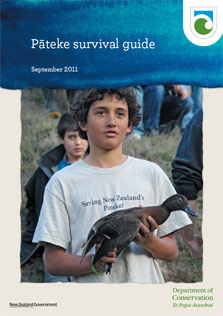Mimiwhangata

PATEKE/BROWN TEAL RECOVERY PROGRAMME
NORTHLAND CONSERVANCY
INFORMATION FOR VISITORS
Wetlands and ponds, farmland, and bush edges on and around the Mimiwhangata Coastal Park form the last mainland stronghold for the critically endangered pateke or Brown Teal (Anas chlorotis). This small, secretive, mostly nocturnal duck is under threat from predators and habitat modification. About 250 are found in this area; a larger population of up to 1000 birds survive on Great Barrier Island.
A sample of birds from the Mimiwhangata population are fitted with radio-transmitters to enable their movements, feeding and breeding patterns to be followed. At the end of this month, 41 birds carry radio-transmitters.
The breeding season is in full swing, with adult males and females looking very impressive at the moment in full breeding plumage. This species is certainly not just a boring brown duck! The breeding season usually runs from May to November, and all the females carrying transmitters will be closely monitored during this time. Five pairs are already protecting broods of ducklings, and another six females are incubating a nest of eggs. Two male juvenile fledglings were banded and radio-tagged at the end of August – the first young of the year to fly. At this time of year only young and/or non-breeding birds are seen flocking or gathering together in small numbers at traditional open water or estuarine sites.
Predator control is carried out at Mimiwhangata and adjacent private landowner properties, as well as areas around Whananaki. This targets mustelids (stoats, weasels, ferrets) and cats as the main predators of pateke. However, rats, hedgehogs and pukeko are also controlled. Stray and hungry dogs remain a threat to teal.
For further information, contact
Tiff Browne

